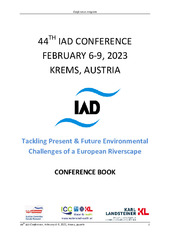Приказ основних података о документу
In situ genotoxicity assessment in the weight-of-evidence approach – The Joint Danube Survey 4 case study
| dc.creator | Kračun-Kolarević, Margareta | |
| dc.creator | Jovanović Marić, Jovana | |
| dc.creator | Đorđević, Jelena | |
| dc.creator | Sunjog, Karolina | |
| dc.creator | Nikolić, Ivan | |
| dc.creator | Marić, Ana | |
| dc.creator | Ilić, Marija | |
| dc.creator | Simonović, Predrag | |
| dc.creator | Alygizakis, Nikiforos | |
| dc.creator | Ng, Kelsey | |
| dc.creator | Oswald, Peter | |
| dc.creator | Slobodnik, Jaroslav | |
| dc.creator | Žegura, Bojana | |
| dc.creator | Vuković-Gačić, Branka | |
| dc.creator | Paunović, Momir | |
| dc.creator | Kolarević, Stoimir | |
| dc.date.accessioned | 2024-03-15T09:56:47Z | |
| dc.date.available | 2024-03-15T09:56:47Z | |
| dc.date.issued | 2023 | |
| dc.identifier.uri | http://radar.ibiss.bg.ac.rs/handle/123456789/6592 | |
| dc.description.abstract | Assessment of impact of pollution in the environmental studies requires multi-endpoints approach to properly link cause and effects of pollution with focus on chemical pollution. In this sense systematic weight-of-evidence approach (WoE) with multiple lines of evidence (LoEs) is preferable to apply. The WoE approach highlights the importance to identify strengths and weaknesses of used LoEs. Therefore, in this study we have tested efficacy of genotoxicological endpoints as one of the LoEs in the in situ assessment of pollution effects in the freshwater ecosystems using Alburnus alburnus (bleak) as a bioindicator species. Additional LoEs that were used in the study are: component-based methods for the assessment of SumTU in water based on monitoring data of the Serbian Environmental Protection Agency (SEPA), effect based methods employing in vitro genotoxicological analyses of Joint Danube Survey 4 (JDS4) water extracts and field derived species inventories for the assessment and indication of ecological status/potential based on SEPA and JDS4 data. The study was conducted within the JDS4 campaign at nine sampling sites at the Tisa, Sava, Velika Morava and Danube rivers in the Republic of Serbia. In the case of three sampling sites, the results were uniform, meaning that all four LoEs pointed to pollution pressure. The differences in the LoEs outcomes for other sites indicated the importance of multiple LoEs approach for proper identification of ecological impact. In the case of current study we have identified comet and micronucleus assay to be appropriate for the genotoxicological assessment in the in situ studies due to high sensitivity in discrimination of sites in relation to pollution intensity, while RAPD analysis to be more suitable for controlled ex situ investigations. | sr |
| dc.language.iso | en | sr |
| dc.publisher | Austrian Committee - International Association for Danube Research | sr |
| dc.rights | openAccess | sr |
| dc.source | Conference Book: 44th IAD conference: Tackling Present & Future Environmental Challenges of a European Riverscape; 2023 Feb 6-9; Krems, Austria | sr |
| dc.title | In situ genotoxicity assessment in the weight-of-evidence approach – The Joint Danube Survey 4 case study | sr |
| dc.type | conferenceObject | sr |
| dc.rights.license | ARR | sr |
| dc.rights.holder | © 2023 by the Austrian Committee - International Association for Danube Research | sr |
| dc.description.other | Conference Book: 44th IAD conference: Tackling Present & Future Environmental Challenges of a European Riverscape; 2023 Feb 6-9; Krems, Austria. Austrian Committee - International Association for Danube Research; 2023. p. 18. | sr |
| dc.citation.spage | 18 | |
| dc.type.version | publishedVersion | sr |
| dc.identifier.fulltext | https://radar.ibiss.bg.ac.rs/bitstream/id/17059/2023_AbstractBook_44th_IAD_conf_Krems3.pdf | |
| dc.citation.rank | M34 | |
| dc.identifier.rcub | https://hdl.handle.net/21.15107/rcub_ibiss_6592 |

